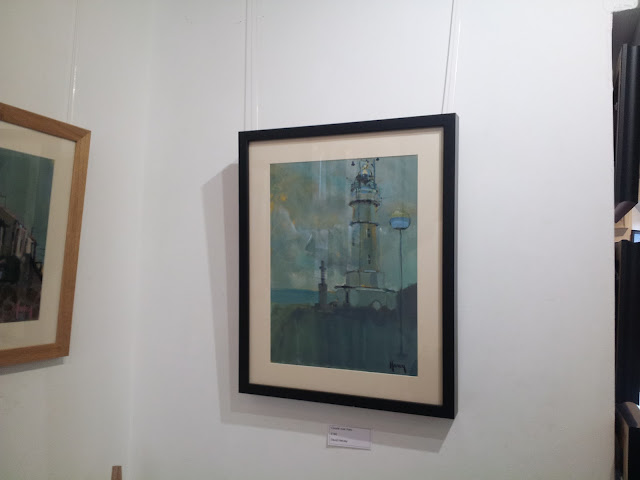Saturday, yesterday that is, I had some bookshop business in
Margate which I decided to combine with a bit of painting, as most of you know
I don’t paint much from photographs and mostly paint from life. Up to now this
painting has been with watercolour paint and paper.
This is mainly because the whole kit goes in my pocket, with
this type of painting really any small paintbox, some brushes and a pad will
do. The really important thing is not to make things to complicated, by this I
mean, stick to the same type of pad so you gradually get to know what will
happen when you put paint on that particular paper, stick to the same make of
paint, I squeeze tubes of watercolour paint into the segments of the paintbox
and in the winter I put it on the radiator and in the summer I put it in the
sun until the paint has gone hard. I have a limited number of brushes and know
what to expect when I use them, I also use a natural sponge.
You can throw money at this, I use expensive sable brushes
called Winsor and Newton number 7s, I use Winsor and Newton artist’s quality
paint, I think the paint is averagely around £12 for a big tube and I get
through about 2 tubes a year. I think the brushes are also averagely around £12
and none of these have worn out or gone wrong yet.
I didn’t have painting lessons or look at instructional
videos, but just sort of got on with it, mainly because I want to develop my
own style and with watercolour this now is just putting paint onto blank paper,
which often just doesn’t work out very well.
Anyway I have decided to have a go with oil paint and
canvas, the equipment for this is much more difficult to cart about.
You have a palate, which you squirt the paint onto and mix
the paint on, you need to be able to cart this about without the paint side
touching anything. When you have painted or part painted a canvas it takes ages
to dry, so you also have to be able to cart this about without it touching
anything. The main problem though is the Paddington Bear effect in which the
paint behaves like marmalade, it gets on your hands, then you get an itch on
your nose or in your hair so it gets there.
At the moment I am mainly practicing the carting about, but I
have discovered that the oil equipment, French easel and shopping trolley with a
folding seat also doubles as a portable table and chair meaning I can paint
watercolour anywhere.
Here are the photos from the last two days.
If one of your children has tried out your paints the only thing to do with the palate is to sandpaer the paint off.
some thoughts on this Margate mission
Take a screwdriver that fits the screws that hold the French easel together.
Don’t pour linseed oil into the dipper, but use it straight from the pot as cleaning out the pot enough to put it away afterwards is tricky.
Take a pair of pliers to open difficult tubes or free up all the tube caps before you go.
Lay the cloth you intend to use for brush cleaning out rolled into a tube on the easel drawer and don’t touch the cloth with your hands, by dipping and then dabbing the brushes on it I managed to avoid getting paint on my hands.
Take some bulldog clips and some kitchen towel.
Some Thoughts on this Ramsgate mission.
I bought a £2.99 groundsheet from Wilkinson's as I didn't want to get sand on everything, it also stops the easel and chair from sinking into the sand.
If you are going to sit painting for an hour or so I recommend a blow up cushion from the £1 shop.
The bungee held down the watercolour box and brush roll stopping it from being blown into the sand.
At this point I was ready to have a go with the oil paints, but my children had had enough and wanted to go shopping in Canterbury.
A bit more practice before i have the nerve to oil paint in the middle of Canterbury.





















































